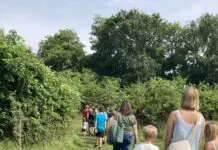The bald eagles of eastern Oklahoma’s Sequoyah National Wildlife Refuge hatched baby eagles right on schedule this year, just as they did in 2011.
Of course, you already know that, if you are one of the 150 or so people who participated in the refuge’s annual Eagle Watch Tour, or you have watched the eagles’ exploits on the live “eagle cam” feed.
Sequoyah National Wildlife Refuge is a great destination even without eagles. Just south of I-40 about 30 miles shy of the Arkansas border, the refuge features everything from bobcats to coots to snow geese. But during nesting season, bald eagles are the main attraction.
“There are many things to see, but everyone wants to see nesting eagles,” says Leann Bunn, a naturalist at nearby Tenkiller Lake. “There’s just something about that majestic bird and seeing them on the nest.”
With its distinctive white head and tail, hooked beak and what appears to be a fierce, penetrating gaze, a bald eagle is indeed a sight to behold. One can do exactly that on the refuge’s annual Eagle Watch Tour. Since 2001, the Sequoyah refuge has offered the tour on seven consecutive Saturdays in January through March.
The tour begins at refuge headquarters, where visitors watch the eagle cam feed on a 64-inch display. It is a remarkable sight: an eagle pair building their nest, incubating the eggs, eggs hatching and parents feeding their chicks.
The eagle cam can also be viewed online and receives more than 4 million hits a year. Those who have watched this season’s reality show unfold saw three eagle eggs laid and hatched. The live feed (at www.suttoncenter.org) will continue until the eaglets “fledge” sometime in mid- to late-April.
As tour visitors watch the eagle cam, Ford and Bunn provide color commentary. Then the group loads up on the tour bus to view the eagles in their habitat. From a distance of 250 yards, visitors are able to watch the eagles through binoculars and spotting scopes.
Although bald eagles were once present in abundance all over our country, by the mid-20th century the species was nearly gone. No bald eagles were sighted in Oklahoma for several decades.
“That’s right,” says Bunn. “We almost didn’t have any bald eagles left in Oklahoma.”
Thanks to the Bald Eagle Protection Act (1940), the Endangered Species Act (1973) and the work of organizations such as the Sutton Avian Research Center near Bartlesville, bald eagles are thriving again in Oklahoma.
“The number of nesting bald eagle pairs in the state of Oklahoma was 70 to 75 in 2009. That number was up to about 100 last year,” says Chad Ford, visitor services specialist for Sequoyah National Wildlife Refuge.
The 2012 Eagle Watch Tour is over now. However, Ford was quick to say, “Tell everyone to be ready for next year.” The tour begins again on Jan. 19, 2013, and continues for six successive Saturdays. Tours are free and no registration is required. Just show up at the refuge headquarters at 9 a.m.
“I’d love to see more people coming for the tour,” Ford says.

























